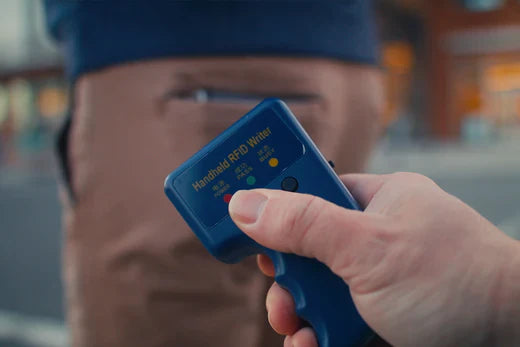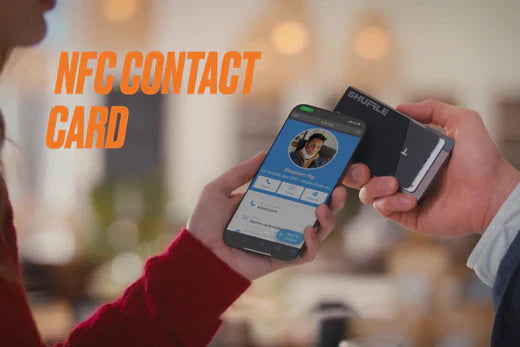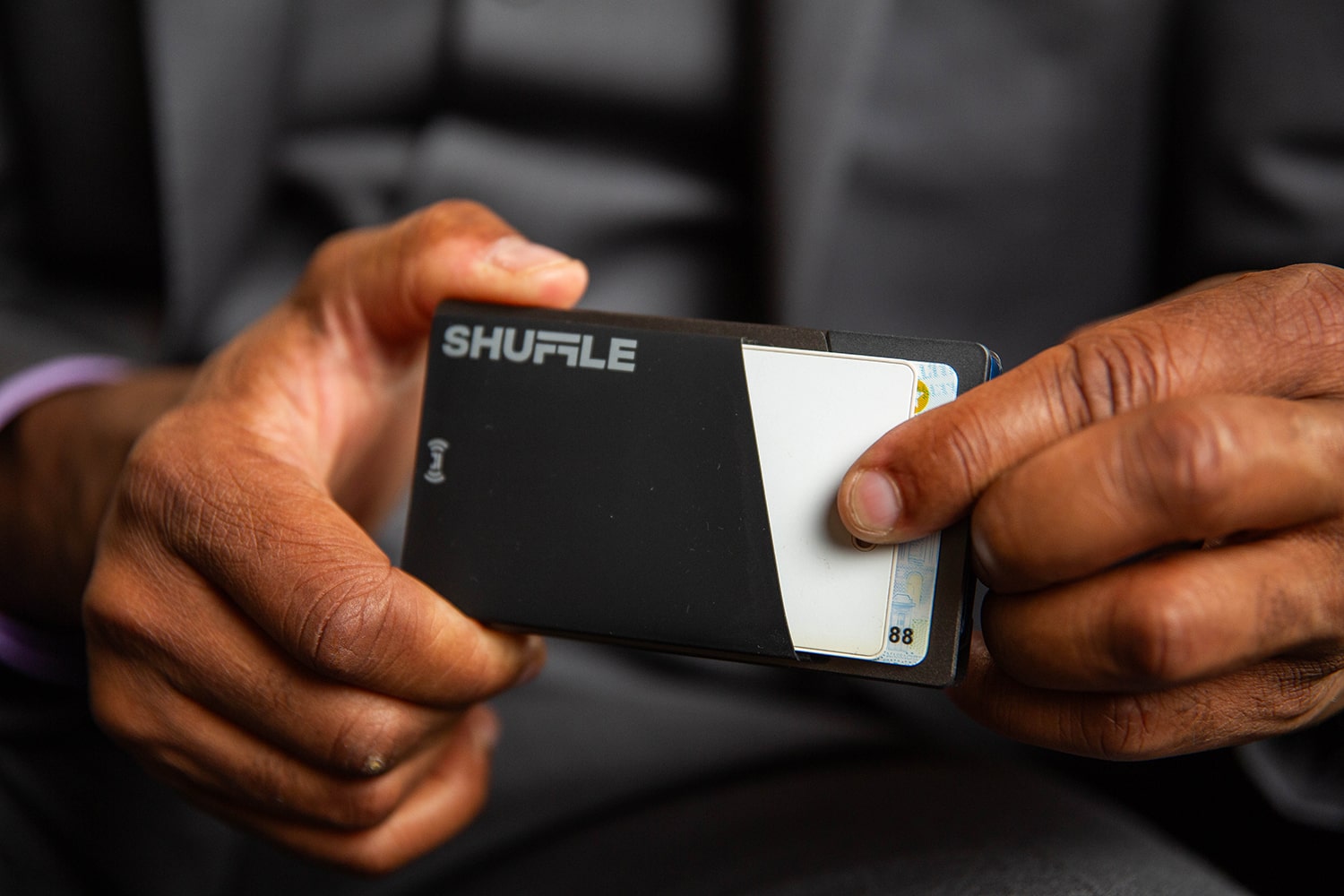Radio-frequency identification has led to countless innovations in many industries. It has improved inventory management, enhanced supply chain visibility, helped automate processes, enhanced security, and strengthened data management.
But like a coin, it has two sides.
We’re living in a digital dystopia, where cybercrime has increased exponentially
Ill-intentioned individuals can easily use card skimmers by standing beside consumers. Modified readers then read information on credit cards and key cards to fabricate nefarious charges and/or retrieve sensitive personal information.
This has prompted the development and rise of RFID-blocking technology. Learn more about RFID, its risks, RFID blocking solutions, and more with Shuffle Wallet.
What Is RFID?
RFID, or radio frequency identification, is a passive technology through which items or individuals can be uniquely identified and monitored using radio waves.
An RFID system works in one direction, using three main elements:
- A tag
- A reader
- A backend system
When a tag is triggered by an electromagnetic pulse from a reader that uses a specific frequency band, it communicates with the reader by reflecting the signal back, a process known as backscatter. The reader’s transceiver then converts the radio waves into usable data, allowing the information to be processed and stored in a database.
RFID is categorized into three types:
- Active:Battery-powered. They have a read range of up to 100 meters and store 128 kilobytes of information. This makes them valuable for tracking high-value items.
- Passive:Has no internal power source and relies on the reader to initiate the tag’s microchip or integrated circuit (IC). Since it has a short read range of up to 10 meters, it’s best used for tracking and regulation in controlled areas.
- Semi-passive:Offers the benefits of both active and passive RFID. It has a long read range of up to 100 meters but only works when it’s within range of the reader.
RFID has become relevant in a wide range of industries, including health, banking, social security, retail sales, customer service, shipping, and insurance. It’s also used for vehicle, pet, and livestock tracking as well as tap-and-go credit card payments.
But, it has several security vulnerabilities that make it prone to criminal intent.
What Is RFID Blocking Technology? How Does It Work?
RFID readers can read information without physical contact. Tags (which contain unique identification numbers) can be scanned automatically when moving people or items come within the range of a reader. This creates tremendous potential for abuse, hence, the need for RFID blocking.
RFID blocking works by inserting special materials like carbon fiber and aluminum between the reader and the card. This creates a Faraday cage, which interferes with the electromagnetic field emitted from a transceiver and keeps it from penetrating the hard case to prevent unauthorized access to sensitive information.
Though RFID-blocking technology affords you some level of protection, it isn’t 100% effective. It can experience interference from other wireless systems.
The Vulnerabilities of RFID
There are security and privacy issues when using touchless technology.
Consider its impact in the realm of data exchange for instance. Criminals can easily intercept or clone your data from your passport’s ID, driver’s license, or credit card through skimming reverse engineering a vulnerable RFID reader eavesdropping and tampering (spoofing) man-in-the-middle attacks, and remote power analysis attacks, which can be particularly problematic as tags draw power from the RFID reader through an energy coupling mechanism.
When a scammer steals personally identifiable information (PII) on a chip-enabled card, the risk goes beyond the loss of money. It also puts you at risk of identity theft .
This can expose you to serious consequences like:
- Account takeover fraud
- Damaged credit history and score
- Illegal transfer of ownership of your home
- The filing of a federal tax return in your name
- Opening credit cards and taking out new loans in your name
This type of crime has affected a lot of businesses and individuals.
Let’s consider the Saflok-brand RFID-based keycard locks installed on over 3 million doors. In 2022, a team of IT security researchers identified a series of serious security vulnerabilities that could allow hackers to gain access to all of them using a single customized keycard. The only solution is to upgrade each hotel, which is a time-intensive process.
RFID-Blocking Solutions
RFID-blocking solutions disrupt the electromagnetic signals transmitted by the card reader, discouraging theft. Popular options include:
Wallets

Pros: Products like Shuffle Wallet effectively block RFID signals, preventing thieves from illegally accessing your money.
Cons: None.
Purses
Pros: This is the top choice if you carry multiple RFID-enabled objects like passports, credit cards, and ID cards.
Cons: It can be expensive, and the level of protection multiple compartments offer can vary.
Clothing
Pros: The material is soft, breathable, and effective against skimming.
Cons: Designs of RFID-blocking clothes can make it difficult to access your cards during transportation, etc.
Card Sleeves
Pros: Slim and lightweight. It can help keep your personal information protected and secure.
Cons: You’ll have to remove your cards during each transaction.
Choosing the Right RFID Blocking Solution
So, how do you pick the right product for you? Look for:
- High-performance materials that are highly resistant to wear.
- Products that fit your RFID items. For example, if you’re getting a wallet, it should fit multiple cards with room for cash.
- RFID-blocking features. An NFC-enabled contact card compartment is a bonus.
It doesn’t hurt to look for designs and functionalities that suit your lifestyle. For instance, if you need to pay for various transactions quickly, a product that enables you to easily remove individual cards without fumbling will prove handy.
Best Practices for RFID Security
The astronomical impact of RFID technology is undeniable. As an industry, RFID is expected to be worth $40.9 billion by 2032, which can be attributed to the convenience it offers and its ability to work in harsh conditions (including sub-zero temperatures, high-impact or explosive environments, and sweltering heat).
But don’t be blindsided by its many benefits as it also poses certain risks to your safety and security. Luckily, you can minimize them with these best practices:
- Use the right product. Minimalist wallets are your best choice. They’re slim and don’t create an unsightly bulge in the front pocket of your jeans.
- Store your cards separately in organized compartments. This makes it easy to retrieve the right card while deterring theft.
- Be aware of your surroundings when you use your cards. Since they’re contactless, it’s important to ensure no suspicious people are near you.
- Don’t travel with too many cards.
Finally, stay informed about the latest trends and technologies in the RFID industry. Doing so will help you understand the security risks and adapt accordingly.
Final Thoughts
Enjoy the benefits of RFID without exposing yourself to unnecessary risks. If you have RFID credit cards, store them in RFID-blocking products. The Shuffle Wallet is a pocket-sized RFID-blocking solution that can discreetly fit up to nine cards.
Choose from three colors and enjoy peace of mind.





Leave a comment
This site is protected by hCaptcha and the hCaptcha Privacy Policy and Terms of Service apply.